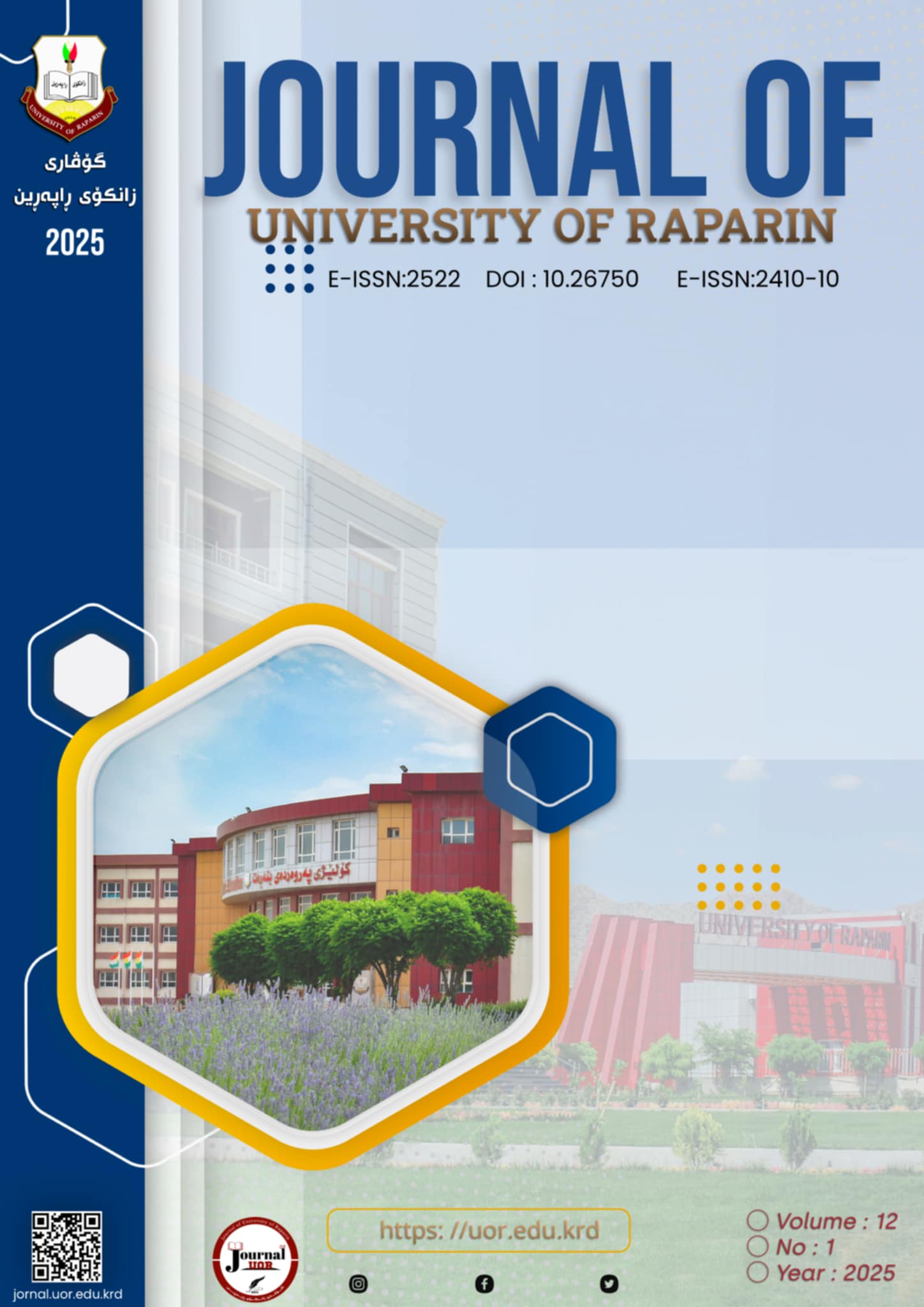Abstract
The main subject of this study’s discussion is to achieve the main goal of revealing the behavioral effects of the distorting media content on the social media websites on the universities’ youth, as a social stratum, who are users of such sites and are more exposed, and the interpretation of the effects obtained from their exposure. The study is based on a qualitative approach with the aim of reaching a deep and accurate understanding of the phenomenon and its interpretation of the behavioral effects on the universities’ youth, which were carried out through the use of in-depth interview tools in the form of non-random-purposed sampling with (20) students of the Sulaymaniyah Polytechnic University. The most important findings of the study: A large number of the universities’ youth are confused by the vast amount of information that is published on social media websites on a daily basis, which has led to doubts about the ability of young people to distinguish real media content from the misleading content. The misleading media content evokes feelings of anxiety, fear, and lack of will among the universities’ youth. This misleading content promotes low-quality cosmetics in the e-commerce process, thus influencing the purchasing decisions of the university youth, which has led to their detrimental health and financial well-being.
References
عبان، الربيع، جويني، عبداالوهاب،(2022)، دور العلاقات العامة الرقمية في مواجهة الأخبار الكاذبة والمضللة، رسالة ماجستير، جامعة العربي التبسي، كلية العلوم الانسانية والاجتماعية، قسم علوم الاتصال.
الرزاقي، نبيلة، (2021)، تجريم نشر وترويج الشائعات الإلكترونية عبر مواقع التواصل الاجتماعي، المجلة الأكاديمية للبحث القانوني، المجلد(12)، العدد(خاص).
ابراهيم، سهير صالح، (2019)، أثر الأخبار الكاذبة على مواقع التواصل الاجتماعي فى نشر القلق السياسى لدى الشباب، المجلة المصرية لبحوث الرأي العام، جامعة القاهرة: كلية الاعلام، المجلد(18)، العدد(4)، ديسمبر.
حسني، ايمان محمد، (2019)، آليات التضليل الإعلامي في الخطاب الخبري الصادر عن الصفحات الزائفة المنتحلة لأسماء الصحف المصرية الشهيرة على شبكة الفيسبوك، المجلة المصرية لبحوث الرأي العام، جامعة القاهرة: كلية الاعلام، المجلد(18)، العدد(1)، مارس.
حماني، اسماعيل، وآخرون، (2022)، أثر الأخبار الزائفة المروجة عبر مواقع التواصل الاجتماعي على الصحة النفسية في ظل أزمة كورونا، المجلة الجزائرية لبحوث الإعلام والراي العام، المجلد (5)، العدد (1)، جون.
سالم، حمدان خضر، شبيب، جاسم محمد،(2018)، طرائق مواجهة الشائعات في مواقع التواصل الاجتماعي الفيس بوك، بحث مستل من اطروحة دكتورا، مجلة الباحث الإعلامي، المجلد(10)، العدد(41).
الصالحي، أبوبكر حبيب، (2020)، دور مهارات التفكير الناقد لدى طلاب الجامعات المصرية في دحض الأخبار الزائفة عبر وسائل التواصل الاجتماعي، مجلة البحوث الإعلامية، جامعة الأزهر: كلية الإعلام، العدد(54)، الجزء(6)، يوليو.
مبارك، عبدالسلام، (2022)، تعرض الشباب الجامعي للاخبار الزائفة على مواقع التواصل الاجتماعي وعلاقتها باتجاهات الشباب الجامعي نحو القضايا المثارة في المجتمع المصري، مجلة كلية الآداب، جامعة سوهاج، العدد(62)، الجزء(2).
مبارك، عبدالسلام، (2022)، تعرض الشباب الجامعي للاخبار الزائفة على مواقع التواصل الاجتماعي وعلاقتها باتجاهات الشباب الجامعي نحو القضايا المثارة في المجتمع المصري، مجلة كلية الآداب، جامعة سوهاج، العدد(62)، الجزء(2).
مصطفى، اسماء محمد، (2016)، استخدام شبكات التواصل الاجتماعي وانعكاساتها على تشكيل قيم الشباب الجامعي، المجلة العلمية لبحوث الصحافة، جامعة القاهرة: كلية الإعلام، العدد(8).
الحيزان، محمد بن عبدالعزيز، (2010)، البحوث الإعلامية، اسسها- اساليبها- مجالاتها، الرياض: ط3، مطبعة السفير.
الخياط، ماجد، (2011)، اساليب البحثوث العلمية الكمية والنوعية في العلوم الاجتماعية، الأردن: عمان، دار الراية للنشر والتوزيع، ط1.
الرازي، زين الدين ابو عبدالله،(1999)، مختار الصحاح, بيروت: المكتبة العصرية-الدار النموذجية، ط5.
زغيب، شيماء ذوالفقار(2009) مناهج البحث والاستخدامات الإحصائية في الدراسات الإعلامية، القاهرة:الدرار المصرية اللبنانية،ط1.
الشميمري، فهد عبدالرحمن،(2010)، التربية الإعلامية، الرياض: مكتبة الملك فهد الوطنية، ط1.
قنديلجي، عامر ابراهيم، السامرائي، ايمان، (2009)، البحث العلمي الكمي والنوعي، الأردن، عمان: دار اليازوري، ط1.
محمد، عمر، شيركو جبار، سامان فوزي، (2020)، سياسة الإعلام وقضايا السلم الاجتماعي، الناشر: منظمة (CDO) اقليم كوردستان العراق: ط1، مطبعة كارو.
الدليمي، نزهت، (2020)، التضليل الإعلامي وكيفية المواجهة، شبكة النبأ المعلوماتية، (انترنيت) https://annabaa.org/arabic/referenceshirazi. تاريخ زيارة الموقع (11/4/2024).
شبكة الصحفيين الدوليين(IJNET)، (2021)، مكافحة التضليل والمعلومات الخاطئة، (انترنت)، https://ijnet.org/ar/story، تاريخ زيارة الموقع (1/2/2024).
العاصي، حسن، (2020)، الإغراق الإعلامي تصنيع الكذب والتضليل، شبكة النبأ الاخبارية،(الانترنت) .https://annabaa.org/arabic/referenceshirazi، تاريخ زيارة الموقع (27/12/2023).
Anouk de Regt, Matteo Montecchi, Sarah Lord Ferguson, (2020). “A false image of health: how fake news and pseudo-facts spread in the health and beauty industry”, Journal of Product & Brand Management, Vol.29,No.2.
Han Luo, Meng Cai, and Ying Cui,(2021), “Spread of Misinformation in Social Networks: Analysis Based on Weibo Tweets”, Security and Communication Networks, Vol(2021),Issus(1), 16 December, pp(1-23).
Azzimonti, Marina, Fernandes,Marcos(2023),”Social media networks, fake news and polarization”, European Journal of Political Economy, January, Vol(76). [online].Available at: https://www.sciencedirect.com. (Accessed: 3/4/2024)
Definition of misinformation noun from the Oxford Advanced Learner's Dictionary, [online].Available at: https://www.oxfordlearnersdictionaries.com (Accessed: 12/3/2024).
Desa, Shevon ,Hailey Mooney, and Jo Angela,(2021) "Fake News," Lies and Propaganda: How to Sort Fact from Fiction, University of Michigan Library, [online].Available at: https://guides.lib.umich.edu/fakenews. (Accessed17/2/2024).
Jeffrey, Gottfried, (2021), Americans’ Social Media Use YouTube and Facebook are by far the most used online platforms among U.S. adults; TikTok’s user base has grown since 2021”, Pew Research Center, [online].Available at: https://www.pewresearch.org/internet,(Accessed: 8/6/2024).
Priscila. Lilla, and Jurberg.(2021)” Misinformation on social networks during the novel coronavirus pandemic: a quali- quantitative case study of Brazil”, BMC Public Health, [online].Available at: https://bmcpublichealth.biomedcentral.com/articles. (Accessed: 15/2/2024)
Schwartz, Oscar (2018). "You thought fake news was bad? Deep fakes are where truth goes to die"., the Guardian, [online].Available at:. https://www.theguardian.com. (Accessed12/2/2024).
Thomas J. Froehlich,)2020), A Disinformation-Misinformation Ecology: The Case of Trump,[online].Available at: https://www.intechopen.com/chapters/74337 (Accessed: 12/1/2024).
Tom Chatfield,(2016), “The trouble with big data? It’s called the ‘recency bias”, BBC World, [online].Available at: https://www.bbc.com/future/article/2016. (Accessed: 8/6/2024).

This work is licensed under a Creative Commons Attribution-NonCommercial-NoDerivatives 4.0 International License.
Copyright (c) 2025 Journal of University of Raparin

